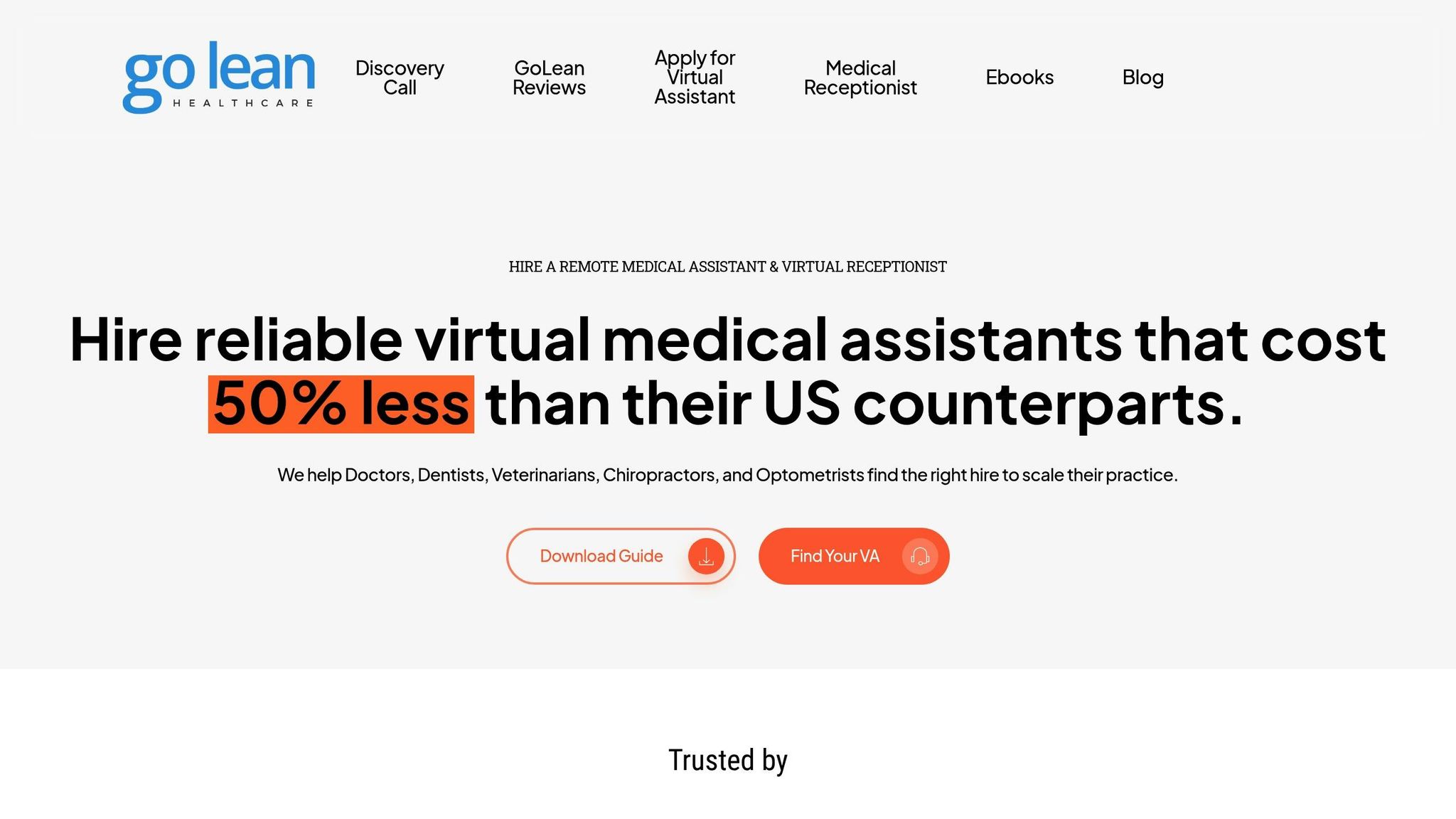Virtual patient onboarding is transforming healthcare by streamlining processes and enhancing patient experiences. Here’s what you need to know:
- Core Features: Digital registration, online scheduling, remote insurance verification, secure communication, and EMR integration.
- Benefits: Reduces wait times, minimizes errors, ensures HIPAA compliance, and improves patient satisfaction.
- Role of Virtual Assistants (VAs): Trained VAs manage tasks like insurance verification, appointment scheduling, and patient communication, saving time and cutting operational costs (as low as $9/hour with services like GoLean).
- Security Measures: Ensuring HIPAA compliance with encrypted data, secure channels, and regular staff training.
- Tools: Integration of EMR systems, automated communication platforms, and performance tracking dashboards.
Takeaway: Combining virtual assistants with digital tools creates a smoother, more secure onboarding process that benefits both patients and healthcare providers.
Core Elements of Virtual Patient Onboarding
Digital Registration Forms and Data Entry
Switching from paper to digital forms is a key step in virtual patient onboarding. Mobile-friendly registration forms help make the process smoother for patients, reducing delays and errors.
Virtual medical assistants are integral to managing these systems. They handle data entry with precision, ensure HIPAA compliance, and provide multilingual support, making the process accessible for diverse patient groups.
"My VA has become a valuable part of my business. Her sensitivity and care for patient data have earned my utmost trust. I love her work ethic, and we get more done in a day because she’s around." – Dr. Marissa Toussaint, Anise Medical [1]
This streamlined data collection naturally connects to efficient online appointment scheduling.
Online Appointment Booking
Self-service scheduling tools are now a must-have for healthcare practices. A good system should offer:
- Real-time availability of time slots
- Instant booking confirmations
- Safeguards against double-booking
- Options for scheduling via web or mobile
Virtual assistants can oversee these systems, ensuring everything runs smoothly. They handle appointment changes, send reminders, and allocate resources effectively for each visit.
"Our team is always delighted by my VA’s bright and happy disposition. At any time of the day, you’ll find him happily answering the phone whether it’s for our patients or our staff and physicians. He is such a delight to work with and we can’t imagine our office without him." – Dr. Trishanna Sookdeo, Sookdeo Family Medicine INC [1]
An efficient scheduling system is the foundation for clear and proactive pre-visit communication.
Patient Communication Before Visits
After an appointment is scheduled, clear communication ensures patients are ready for their visits. Key elements include:
- Immediate confirmation with appointment details
- Preparation guidelines (e.g., necessary records, fasting instructions, medications, or insurance information)
- Timely reminders via email or text
"We’re running a busy practice and our GoLean VA has been an awesome addition to our team. She takes initiative, gets things done, and organizes things for us." – Dr. Giriraj Sharma, Sharma Facial Plastic Surgery [1]
Virtual medical assistants can handle this communication process from start to finish, ensuring patients stay informed and prepared. For practices with multilingual patients, bilingual assistants help bridge any language gaps, improving the overall experience.
Introducing Patients to Virtual Care
Data Security and HIPAA Requirements
Protecting digital patient information is a top priority for successful virtual onboarding in healthcare. Practices need to focus on both strong technical safeguards and thorough staff training to ensure compliance with HIPAA regulations and protect sensitive patient data.
Implementing HIPAA Standards
Handling electronic health information securely requires multiple protective measures. Key steps include:
- Encrypted Data Storage: Use encryption to secure all patient information.
- Secure Communication Channels: Transmit patient data through protected systems.
- Access Controls: Restrict data access based on roles, ensuring only authorized personnel can view sensitive information.
- Audit Trails: Keep detailed logs of who accesses patient data and when.
It’s also crucial to establish Business Associate Agreements (BAAs) with third-party service providers to confirm that everyone involved adheres to HIPAA standards. While these technical measures are essential, ensuring staff follow these protocols is equally important.
Training Employees and Monitoring Security
A well-trained team is critical for maintaining data security and HIPAA compliance. Healthcare practices should prioritize:
Regular Training Programs:
- Provide initial HIPAA certification for all employees.
- Offer ongoing updates on security practices.
- Use practical scenarios to reinforce understanding.
- Keep records of all completed training.
Security Monitoring:
- Conduct routine system audits.
- Perform vulnerability assessments.
- Set up clear incident response plans.
- Continuously monitor performance metrics.
"My experience with GoLean has been amazing. I was worried about having to train my VA so much but to my surprise he already knows how to use the EMR and was already certified for customer service, HIPAA, and more. It had cut down hours of staff training for me, since he got to work right away." – Dr. Venkata Aligeti, Interventional Cardiologist [1]
As Dr. Aligeti highlights, hiring virtual medical assistants who are already HIPAA-certified can save significant time during onboarding while ensuring compliance. Regularly reviewing access logs and updating security protocols can further strengthen virtual onboarding systems and address any potential risks.
sbb-itb-109dad4
Virtual Medical Assistants in Patient Onboarding
Virtual medical assistants (VMAs) simplify the onboarding process by handling both clinical and administrative tasks. This not only improves efficiency but also helps cut costs.
Front Office Task Management
VMAs are skilled at managing essential front office tasks that shape the patient onboarding experience. These include:
- Insurance Verification: Confirming coverage and benefits before appointments
- EMR Management: Updating electronic medical records with patient details
- Appointment Scheduling: Organizing calendars and sending confirmations
- Prior Authorization: Handling requests and follow-ups with insurance providers
- Medical Billing: Submitting claims and managing payments
By delegating these responsibilities to virtual assistants, healthcare providers can save up to 50% on operational costs compared to traditional staffing, all while maintaining high-quality service [1].
Language Support Services
Clear communication is essential during patient onboarding, especially in multicultural communities. Bilingual VMAs help bridge language barriers, ensuring patients fully understand their care. They also promote cultural awareness, comply with legal standards, and enhance patient satisfaction and safety. This level of support is seamlessly integrated into solutions like GoLean’s specialized medical assistant services.
GoLean‘s Medical Assistant Services
GoLean offers virtual medical assistants trained to handle patient onboarding with precision and security. At just $9 per hour [1], these HIPAA-certified professionals provide support across various channels, including email, chat, video calls, and phone.
"Patients keep coming back because our VA has given our clinic an amazing first impression. I’m very confident in our VA and she has represented our practice in the best possible way!"
– Dr. Vishal Bhalani, The Bhalani Urology Institute [1]
Virtual medical assistants ensure a seamless onboarding experience while maintaining the personal connection patients value. Their ability to manage complex tasks and uphold HIPAA standards makes them an essential part of modern healthcare practices.
Digital Tools for Patient Onboarding
In today’s healthcare landscape, effective digital tools are essential for simplifying patient onboarding. When paired with virtual medical assistants, these tools can reduce administrative tasks and improve the overall patient experience.
Software and Platform Integration
A well-integrated system ensures a smoother onboarding process. Here are the key digital components:
EMR and Digital Documentation
Electronic Medical Records (EMR) systems are central to digital onboarding. They connect with other platforms to streamline data flow. Digital forms – such as pre-visit registration, insurance verification, consent forms, and medical histories – automatically populate into the EMR. This saves time and minimizes transcription errors.
Patient Communication Platforms
Automated communication tools keep patients informed and engaged by handling tasks like:
- Appointment reminders
- Pre-visit instructions
- Insurance verification updates
- Post-registration follow-ups
These platforms ensure consistent communication while capturing data efficiently.
Performance Tracking and Improvement
To keep the onboarding process efficient, it’s crucial to monitor and refine performance using digital analytics.
Data Analytics Dashboard
Modern platforms provide insights into key metrics, such as:
| Metric | Purpose |
|---|---|
| Form Completion Rates | Identifies potential accessibility issues |
| Time to Complete | Pinpoints workflow bottlenecks |
| Patient Satisfaction | Highlights areas for service improvement |
| Insurance Verification Speed | Helps optimize the revenue cycle |
Continuous Improvement Process
Regular evaluations help refine the onboarding process:
- Patient Feedback: Analyze patient experiences with digital onboarding.
- System Usage Reports: Assess how staff interacts with the tools.
- Integration Efficiency: Ensure smooth data flow across platforms.
Conclusion
Virtual onboarding combines digital tools, skilled staff, and efficient processes to streamline operations and enhance patient experiences. By leveraging integrated digital solutions that adhere to strict HIPAA guidelines, healthcare practices can improve both efficiency and patient satisfaction.
Shifting to virtual onboarding has shown clear advantages, including better operational workflows, higher patient retention, and practice growth. Virtual medical assistants also help cut costs while maintaining high service standards.
The success of virtual onboarding depends on four main components:
| Component | Key Features |
|---|---|
| Digital Infrastructure | EMR integration, secure communication tools, online scheduling |
| Staff Expertise | HIPAA-trained team, bilingual support, EMR proficiency |
| Process Management | Automated workflows, performance monitoring, continuous improvement |
| Security Measures | HIPAA compliance, secure patient portals, robust data protection |
These elements work together to deliver a smooth, secure, and patient-centered onboarding process. As healthcare increasingly moves toward digital solutions, practices that adopt virtual onboarding position themselves for growth and higher patient satisfaction. Combining skilled virtual assistants with reliable technology and efficient processes ensures a strong foundation for success in today’s digital healthcare landscape.




